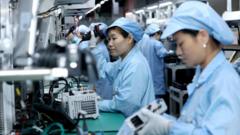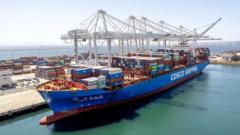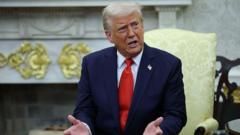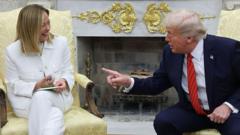The article explores Trump's renewed focus on tariffs against China, the consequences for both economies, and the future of trade relations.
**Trump Intensifies Trade War with China: The Stakes and Implications**

**Trump Intensifies Trade War with China: The Stakes and Implications**
In an escalating trade battle, Trump takes a hard stance against China, signaling potential shifts in global trade dynamics.
Donald Trump's renewed focus on the trade war highlights an increasingly contentious battle with China, suggesting a shift from a broader global trade conflict to a more concentrated struggle between the U.S. and its singular largest trading partner. The current 90-day hiatus on escalating tariffs, which allows for a universal 10% tariff across numerous countries, has not hindered the heightened tension with China. This nation receives far greater punitive measures, experiencing a staggering 125% tariff on its goods — a response to its own 84% levy on U.S. products, which Trump perceives as disrespectful.
For Trump, this is more than just retaliatory politics; it’s an attempt to resolve unfinished business from his first presidential term. He believes previous efforts left unresolved issues that now demand rectification. The objective seems to be reshaping the global trade environment that has historically put China at the forefront as the dominant manufacturing powerhouse.
Reflecting on the past, increased trade with China was once celebrated as a way to boost global economic growth and enhance the lives of its vast labor force. However, the anticipated political reforms and market transitions failed to materialize swiftly, with China continuing to dominate through export-driven policies. Trump's campaign rhetoric in 2016 capitalized on the idea that China's ascension came at a cost to American jobs and economic strength, a narrative that resonated with many Americans.
His previous tenure illustrated a break from conventional trade wisdom, a turn that President Joe Biden has upheld by largely maintaining Trump's tariffs against China. Yet, while they have inflicted pain on China, they have not fundamentally altered its economic strategy. Today, China claims leadership in the electric vehicle sector, producing over half of the world’s electric cars and batteries.
As Trump reemerges on the trade front, a critical juncture lies ahead. One pivotal aspect will be whether China will engage in negotiations and if it is prepared to make meaningful changes to its export-centric economic model. The uncertainties surrounding Beijing’s response to U.S. tariffs pose risks, particularly given its vision tied to economic self-sufficiency and national pride.
Another question looms for the U.S. itself: will it continue to endorse the principles of free trade? Trump's framing of tariffs as beneficial to American industry poses a possible ideological shift towards protectionism. If this becomes a persistent stance, negotiations might prove futile, highlighting an aggressive, unilateral bid for dominance rather than collaborative economic engagement between two superpowers. Such a trajectory could rewrite established norms in international trade, leading to a more fragmented and potentially perilous global economic landscape.





















